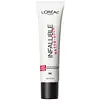L'Oreal Infallible Pro-Matte Lock Primer Versus e.l.f. cosmetics Putty Color-Correcting Eye Brightener
What's inside
What's inside
 Key Ingredients
Key Ingredients

 Benefits
Benefits

 Concerns
Concerns

 Ingredients Side-by-side
Ingredients Side-by-side

Water
Skin ConditioningDimethicone
EmollientGlycerin
HumectantDimethicone Crosspolymer
Emulsion StabilisingPropylene Glycol
HumectantPolyglyceryl-3 Disiloxane Dimethicone
Skin ConditioningVinyl Dimethicone/Methicone Silsesquioxane Crosspolymer
Methyl Methacrylate Crosspolymer
Boron Nitride
AbsorbentPhenoxyethanol
PreservativeCaprylyl Glycol
EmollientPolyacrylamide
Ammonium Polyacryloyldimethyl Taurate
Emulsion StabilisingC13-14 Isoparaffin
EmollientTetrasodium EDTA
Citric Acid
BufferingLaureth-7
EmulsifyingTocopherol
AntioxidantTitanium Dioxide
Cosmetic ColorantWater, Dimethicone, Glycerin, Dimethicone Crosspolymer, Propylene Glycol, Polyglyceryl-3 Disiloxane Dimethicone, Vinyl Dimethicone/Methicone Silsesquioxane Crosspolymer, Methyl Methacrylate Crosspolymer, Boron Nitride, Phenoxyethanol, Caprylyl Glycol, Polyacrylamide, Ammonium Polyacryloyldimethyl Taurate, C13-14 Isoparaffin, Tetrasodium EDTA, Citric Acid, Laureth-7, Tocopherol, Titanium Dioxide
Octyldodecanol
EmollientDipentaerythrityl Hexahydroxystearate/Hexastearate/Hexarosinate
Skin ConditioningSynthetic Beeswax
Emulsion StabilisingSynthetic Wax
AbrasiveSqualane
EmollientVp/Hexadecene Copolymer
CI 77163
Cosmetic ColorantMicrocrystalline Wax
Emulsion StabilisingVp/Eicosene Copolymer
Synthetic Fluorphlogopite
Theobroma Cacao Seed Butter
EmollientPersea Gratissima Oil
Skin ConditioningJojoba Esters
EmollientEthylhexylglycerin
Skin ConditioningPolyhydroxystearic Acid
EmulsifyingLecithin
EmollientEthylhexyl Palmitate
EmollientIsopropyl Myristate
EmollientIsostearic Acid
CleansingPolyglyceryl-3 Polyricinoleate
EmulsifyingTin Oxide
AbrasiveSynthetic Sapphire
Tocopherol
AntioxidantRicinus Communis Seed Oil
MaskingWater
Skin ConditioningGlycerin
HumectantSodium Hyaluronate
HumectantHydrogenated Castor Oil
EmollientPanax Ginseng Root Extract
EmollientPhenoxyethanol
PreservativeCI 77891
Cosmetic ColorantIron Oxides
Octyldodecanol, Dipentaerythrityl Hexahydroxystearate/Hexastearate/Hexarosinate, Synthetic Beeswax, Synthetic Wax, Squalane, Vp/Hexadecene Copolymer, CI 77163, Microcrystalline Wax, Vp/Eicosene Copolymer, Synthetic Fluorphlogopite, Theobroma Cacao Seed Butter, Persea Gratissima Oil, Jojoba Esters, Ethylhexylglycerin, Polyhydroxystearic Acid, Lecithin, Ethylhexyl Palmitate, Isopropyl Myristate, Isostearic Acid, Polyglyceryl-3 Polyricinoleate, Tin Oxide, Synthetic Sapphire, Tocopherol, Ricinus Communis Seed Oil, Water, Glycerin, Sodium Hyaluronate, Hydrogenated Castor Oil, Panax Ginseng Root Extract, Phenoxyethanol, CI 77891, Iron Oxides
 Reviews
Reviews

Alternatives
Ingredients Explained
These ingredients are found in both products.
Ingredients higher up in an ingredient list are typically present in a larger amount.
Glycerin is already naturally found in your skin. It helps moisturize and protect your skin.
A study from 2016 found glycerin to be more effective as a humectant than AHAs and hyaluronic acid.
As a humectant, it helps the skin stay hydrated by pulling moisture to your skin. The low molecular weight of glycerin allows it to pull moisture into the deeper layers of your skin.
Hydrated skin improves your skin barrier; Your skin barrier helps protect against irritants and bacteria.
Glycerin has also been found to have antimicrobial and antiviral properties. Due to these properties, glycerin is often used in wound and burn treatments.
In cosmetics, glycerin is usually derived from plants such as soybean or palm. However, it can also be sourced from animals, such as tallow or animal fat.
This ingredient is organic, colorless, odorless, and non-toxic.
Glycerin is the name for this ingredient in American English. British English uses Glycerol/Glycerine.
Learn more about GlycerinPhenoxyethanol is a preservative that has germicide, antimicrobial, and aromatic properties. Studies show that phenoxyethanol can prevent microbial growth. By itself, it has a scent that is similar to that of a rose.
It's often used in formulations along with Caprylyl Glycol to preserve the shelf life of products.
Tocopherol (also known as Vitamin E) is a common antioxidant used to help protect the skin from free-radicals and strengthen the skin barrier. It's also fat soluble - this means our skin is great at absorbing it.
Vitamin E also helps keep your natural skin lipids healthy. Your lipid skin barrier naturally consists of lipids, ceramides, and fatty acids. Vitamin E offers extra protection for your skin’s lipid barrier, keeping your skin healthy and nourished.
Another benefit is a bit of UV protection. Vitamin E helps reduce the damage caused by UVB rays. (It should not replace your sunscreen). Combining it with Vitamin C can decrease sunburned cells and hyperpigmentation after UV exposure.
You might have noticed Vitamin E + C often paired together. This is because it is great at stabilizing Vitamin C. Using the two together helps increase the effectiveness of both ingredients.
There are often claims that Vitamin E can reduce/prevent scarring, but these claims haven't been confirmed by scientific research.
Learn more about TocopherolWater. It's the most common cosmetic ingredient of all. You'll usually see it at the top of ingredient lists, meaning that it makes up the largest part of the product.
So why is it so popular? Water most often acts as a solvent - this means that it helps dissolve other ingredients into the formulation.
You'll also recognize water as that liquid we all need to stay alive. If you see this, drink a glass of water. Stay hydrated!
Learn more about Water